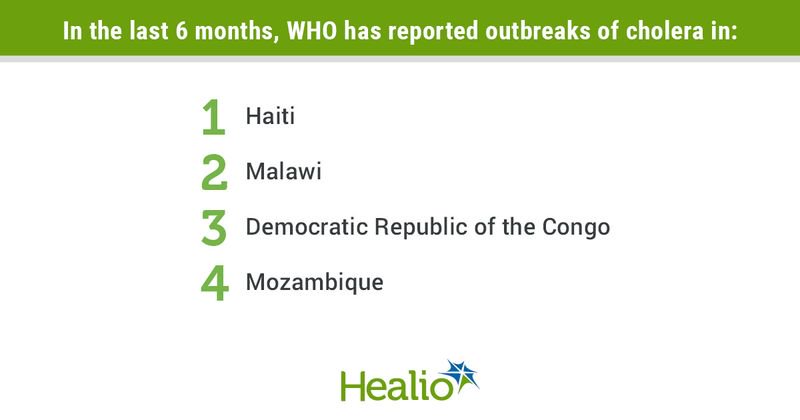Cholera vaccine supply likely to remain limited for years, Gavi says
Key takeaways:
- Globally, approximately 48 million doses of oral cholera vaccine were administered in 2021 and 2022 in response to outbreaks.
- As a result, the global vaccine supply will likely be limited through 2025.
Gavi, the Vaccine Alliance forecasted that the global supply of oral cholera vaccine is likely to remain limited through 2025 if current outbreak trends continue.
According to Gavi, around 48 million doses of oral cholera vaccine (OCV) were administered globally in 2021 and 2022 in response to dozens of outbreaks of the diarrheal illness. That is 10 million more doses than were needed in the previous 10 years combined.

As a result of the increased demand, Gavi said the supply of OCV for preventive vaccination “will likely continue to be limited ... and will need to be allocated transparently and equitably” over the next couple of years.
“By 2026, the roadmap forecasts that supply will start to meet demand for preventive vaccination, thanks to investments in increased capacity and additional manufacturers entering the market,” Gavi said in a news release announcing a new roadmap outlining the actions that are needed to ensure that vaccine supply is able to meet the growing demand.
In a February update, WHO said the global cholera situation had “further deteriorated” since its previous update just 2 months earlier.
“Since mid-2021, the world is facing an acute upsurge of the seventh cholera pandemic characterized by the number, size and concurrence of multiple outbreaks;, the spread to areas free of cholera for decades; and alarming high mortality rates,” WHO said, noting that at least 18 countries continued to report cases, including the Democratic Republic of the Congo, Haiti, Malawi and Mozambique.
WHO announced in October that because of a shortage of cholera vaccine, it would be temporarily suspending its recommended two-dose strategy for OCV. Countries are now advised to use a one-dose strategy, even though protection from one dose of the vaccine appears to be much lower in children compared with two doses.
The outbreaks, “coupled with countries’ increased interest in using OCV for cholera control among other disease control measures, has put a strain on OCV supply, with demand for emergency response spiking,” Gavi said.
In a written plan, Gavi forecasted that the global OCV supply will increase by the end of 2025 because of investments by EuBiologics, BMGF and Gavi itself “in the development of vaccines that can be produced in higher volumes, and the expected entry of a new manufacturer.”
The roadmap itself outlines a three-pronged approach to combating the shortage. In the short-term, Gavi suggested optimizing supply usage and availability in order to provide countries with updated guidance on best use of OCV in emergency responses, to “improve the planning of campaigns and optimize use of doses.”
The approach also includes “ensur[ing] demand for preventive vaccination,” including planning in advance for such programs, and supporting “high-impact vaccine and delivery innovations” as further cholera vaccine candidates are developed.
“The good news is we have doses to meet all emergency demand despite the rise in outbreaks, and that is expected to continue,” Derrick Sim, MD, MBA, managing director for vaccine markets and health security at Gavi, said in the release. “But this trend underscores the increasing importance of preventing outbreaks before they occur. The ultimate solution to both sustainable OCV supply and cholera control lies in our collective ability to step up our efforts on prevention programs.”
References:
WHO. Cholera – Democratic Republic of the Congo. https://www.who.int/emergencies/disease-outbreak-news/item/2023-DON441. Published Feb. 10, 2023. Accessed May 23, 2023.
WHO. Cholera – Haiti. https://www.who.int/emergencies/disease-outbreak-news/item/2022-DON427. Published Dec. 13, 2023. Accessed May 23, 2023.
WHO. Cholera – global situation. https://www.who.int/emergencies/disease-outbreak-news/item/2022-DON426. Published Dec. 16, 2023. Accessed May 23, 2023.
WHO. Cholera – global situation. https://www.who.int/emergencies/disease-outbreak-news/item/2023-DON437. Published Feb. 11, 2023. Accessed May 23, 2023.
WHO. Cholera – Malawi. https://www.who.int/emergencies/disease-outbreak-news/item/2022-DON435. Published Feb. 9, 2023. Accessed May 23, 2023
WHO. Cholera – Mozambique. https://www.who.int/emergencies/disease-outbreak-news/item/2023-DON443. Published Feb. 24, 2023. Accessed May 23, 2023.
Shortage of cholera vaccines leads to temporary suspension of two-dose strategy, as cases rise worldwide. https://www.who.int/news/item/19-10-2022-shortage-of-cholera-vaccines-leads-to-temporary-suspension-of-two-dose-strategy--as-cases-rise-worldwide. Published Oct. 19, 2023. Accessed May. 23, 2023.
